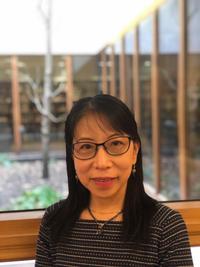Our Five Senses, a new exhibition in Parkway Central Library's Dietrich Gallery opened last month, and we have the honor of sitting down with some of the authors and illustrators who appear in the show. This month, we'll discuss the artist book Dinner Table with its creator, Eriko Takahashi.
Eriko, Dinner Table, is very special because it’s an artist’s book, [Note to readers: This means that it was handmade and its creation is part of the overall artistic experience of the book.] What inspired you to create this unusual book?
Dinner Table is a memorial to my monotype prints, stolen in Santa Fe, NM. I never found the original prints but fortunately I was able to reproduce the images from slides and, many years later, revive them into an artist’s book.
When I created the original prints, I first made an etching plate with circle and square shapes. They seemed like a couple who were eating together at a dinner table during occasions. The locations and conversations at each dinner table became the titles of prints. For example, the first opening, Dinner Table I. Chinatown became the setting for "Let’s have dinner.", the second opeing, Dinner Table II. Japanese Tea Garden became the setting for "Will you marry me?" and so on.
The series of prints became a story and I recognized its narrative quality, so it inspired me to create the book.
The images in the book are created using offset prints. Can you tell us a little more about this process and why you chose that artform for the illustrations?
My original images were prints: monoprints, etching and Chine-collé. As I mentioned, the original prints were gone, but I was able to reproduce the images from slides into postcards with offset printing. I hoped to find my stolen artwork someday by spreading these hundreds of reproduction postcards. [Editor's Note: No luck.]
Monoprints can only be made once, which is unusual because most printmaking allows for multiple originals. My monoprint began with an etched plate, and the image on this plate underlies all of the prints in the series.
Monoprints emphasis just how special artist's books can be. It also illustrates how different an artist's book is from a mass-market book. Most mass-market books are created with either glue or a combination of sewing and glue. Your book was bound using a single-flag structure. Tell us a little more about how the book was physically created.
I made this artist’s book (an edition of 60) for the University of the Arts MFA Book Arts + Printmaking Alumni Exhibition, Thesaurus: A Book Exchange. The offset postcard images were attached on the pages, and the text (including hand-writing) was printed on a Letterpress from polymer plates on textured paper. The boards/spine were covered with table cloth linen fabric. I bound this book using a drum leaf binding; this adhesive binding is the perfect structure to present visual narratives with no sewing thread, which can be made in a home studio. The binding lets the book opens flat, which i think lends itself nicely to edition work.
That's fascinating! Most people may not realize the amount of thought that goes into in the physical structure of the book. We're glad you talked about it. Now let's talk about the content: the book is opened to an illustration and text about a Mexican Chili war and you can feel the heat coming off that page! Why Chili?
Hot chili is yummy but can hide intense spiciness that you don’t see until you taste it, like in a relationship. Also the hot steam coming off the chili suggests something is heating up underneath, like war is coming.
That sounds like a lot of relationships. You take reader to many interesting locations, including a Japanese Tea House, Chinatown, and home. Were these locations chosen for a reason?
These locations are my imaginary dating spots for a relationship in process. Some of the places are based on my experiences in Seattle where I first lived in the US.
Hopefully it will inspire local singles to try similar places. Thank you for chatting with us Eriko!
Our Five Senses is open now through November 2, Monday-Saturday, 9:00 a.m. - 5:00 p.m. For more information, please visit www.freelibrary.org/fivesenses
Visitors can also sign up for free curator-led tours during the exhibition!
Support for this exhibition has been generously provided by Independence Foundation and PNC. The Free Library of Philadelphia gratefully acknowledges additional contributions from individuals.
Have a question for Free Library staff? Please submit it to our Ask a Librarian page and receive a response within two business days.



